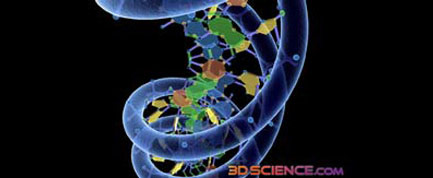What's in Your Genes? Ancient Parasites

You may not know it, but you're part virus.
At least, some of your genes come from viruses that slipped their DNA into the genes of our primate ancestors millions of years ago.
The DNA remnants of these ancient "retroviruses," distant relatives of today's HIV, account for an estimated 8 percent of the human genetic code and may have enabled master genes that account for some of the differences between us and our chimpanzee relatives.
Master genes
Not all genes are created equal; the master genes can turn the others on and off, thus gaining control over genes related to cell division, DNA repair and programmed cell death. (This regulation of genes allows for tighter control of gene expression (i.e. which genes are turned on or off), which can account for the wide differences between humans and other apes, despite our very similar genetic codes.)
One such gene, called p53, has the job of coordinating the surveillance system that monitors the well-being of cells. It is so important in this job that when it fails, cancer is often the result—biologists even call it the "guardian of the genome."
Scientists had long wondered how genes such as p53 built their powerful empire over other genes. A new study detailed this week in the online edition of the journal Proceedings of the National Academy of Sciences implicates the ancient retroviruses as the force behind p53's rise to power.
Sign up for the Live Science daily newsletter now
Get the world’s most fascinating discoveries delivered straight to your inbox.
Repetitive DNA
Scientists at the University of California, Santa Cruz, analyzed and compared genetic data from different species and found that certain retroviruses entered the genome about 40 million years ago and spread rapidly in primates about 25 million years ago.
Earlier research had shown that the DNA remnants of retroviruses like to jump around in the genetic code, and it's this movement into new positions throughout the human genome that spread copies of repetitive DNA sequences, which in turn allowed p53 to regulate many other genes, the UCSC team said. (The association between the sequences and gene regulation had been suspected as far back as 1971.)
"This would have provided a mechanism to quickly establish a gene regulatory network in a very short evolutionary time frame," said lead researcher Ting Wang.
The results also call into question previous views that these repetitive sequences, or so-called junk-DNA, didn't code for anything or serve a particular purpose.
"We're starting to uncover the treasure in this junk," Wang said.
- Top 10 Mysterious Diseases
- Inside Look: How Viruses Invade Us
- The Top 10 Worst Heredity Conditions

Andrea Thompson is an associate editor at Scientific American, where she covers sustainability, energy and the environment. Prior to that, she was a senior writer covering climate science at Climate Central and a reporter and editor at Live Science, where she primarily covered Earth science and the environment. She holds a graduate degree in science health and environmental reporting from New York University, as well as a bachelor of science and and masters of science in atmospheric chemistry from the Georgia Institute of Technology.










